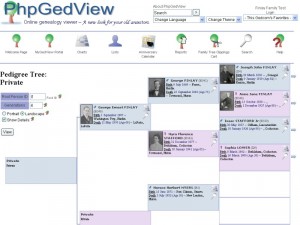PhpGedView puts your ancestors on the web
PhpGedView is an open source application that lets you post your genealogy records on your Web site. It has a lot of interesting features, and makes viewing and editing all aspects of your genealogy easy and fun.

PhpGedView is written in PHP and needs a database such as MySQL or PostgreSQL. To run it, you just need to download the zipped archive and extract the contents somewhere inside the document root of your Web server. Then you must create an empty database and point your browser to the directory where you extracted the archive. The configuration page should open, and you must enter some settings like the database name, username and password, and whether users can request an account. When you have filled all the fields, you’re almost done.
If you have already created a family tree with another application you can export it in GEDCOM format and upload that file directly. If not, you can store your family members in PhpGedView. When you select a person you can see and add the Close Relatives (wife, husband, and children). To add a new person into the system, select an already inserted one and click on Add Wife, Add Husband, or Add Child. After you’ve entered some relatives, you can reach any random person from any other by clicking through the Close Relative view, and you are sure that all the people are connected together. You can add an unlinked person from the administrator menu and then connect it to another, but it’s easy to make mistakes doing that or leave people disconnected.
Click to enlarge For each person in the system you can add a tremendous amount of data: date and place of birthday and death, job, religion, and photos, just to name a few. Most of the data you insert can be used for statistical reports and diagrams. For example, you can see all the people alive in 1890, or display birthplaces with little flags on Google Maps.
Even if you have entered only people’s names in your genealogy database, you can still create a lot of interesting representations, including diagrams and charts showing the connections between people. For instance, there is the classical tree-like Pedigree Chart, or the Relationship Chart, where you can see the relationship between two people. If you want to print information, there’s a good selection of PDF reports available.
One of the most interesting features of PhpGedView is its ability to let Internet users have an account. This way anyone that you, the administrator, accepts can contribute to improving the genealogy records: adding new people, correcting mistakes, inserting birthdays, and so on. You can for instance add your family, then give an account to your uncle, who can add his family (maybe inserting some details you don’t remember). If you give an account to someone you don’t trust, you can specify that any changes he makes must be approved by an administrator before being visible online.
PhpGedView has also some privacy settings. If you don’t want everyone to be able to see your date of birth, for example, you can specify that people’s personal details are viewable only by registered users. There are also some display themes to choose from, and you can specify which languages are made available to users.
PhpGedView is not as user-friendly as you might like. This is particularly troublesome for ordinary users, such as relatives without a lot of genealogy knowledge. For example, adding the date of birth without using the provided JavaScript calendar can lead to little problems. If you enter it in a incorrect format (say 2007-08-01 instead of 01 Aug 2007) all seemes OK, but the date cannnot be used for statistical purpose and won’t be translated to other languages. If someone has made changes to the genealogy (added or modified people) that you have to review, there is a little link at the bottom of the page that the first time is not easy to find.
Apart from these little flaws, PhpGedView is a great application. If you want to collaborate with others on researching your relatives, give it a shot.